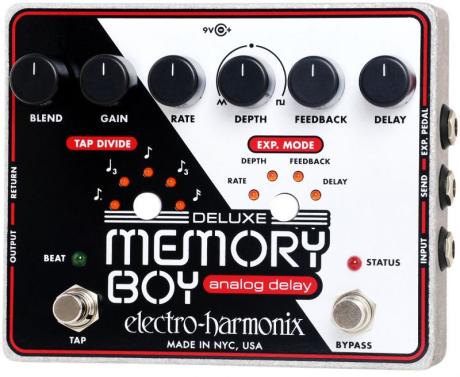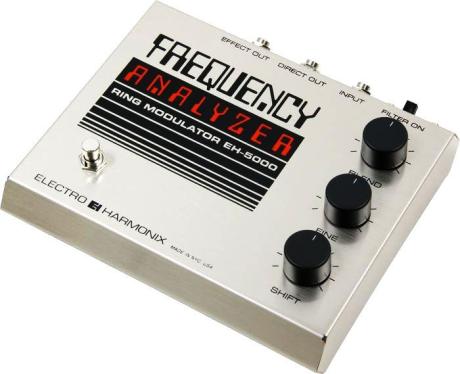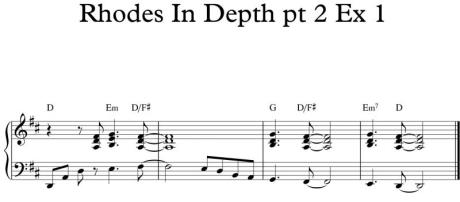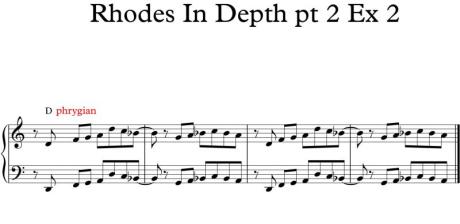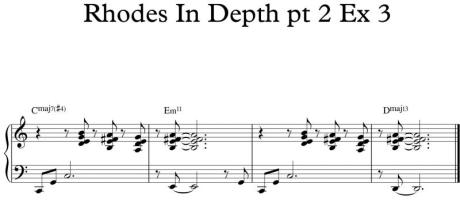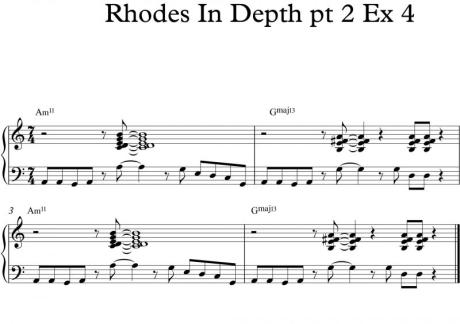Rockové klávesy XXII - workshop

I hope you enjoyed last month's intro tothis great instrument. This month I want to talk about a few more greatplayers. I also wanted to talk a little more in depth about some of the commoneffects used on a Fender Rhodes.
MXR Phase 90: This is a phase shifterreleased in 1974. There are obviously a lot of companys that make this effect,but this one for some reason is the one that sounds the best. It was the firstpedal sold by MXR . The original came in a simple orange enclosure. This unithas just one control for speed which is usually set to a relatively slow speed.The effect produces a gentle shimmery wash that gives a nice motion to thesound.

Here's a video of a more modern MXR phaser,the Phase 100:
https://www.youtube.com/watch?v=p8YWXiprTWA
Ring Modulator: Ring modulation is a typeof amplitube modulation performed by multiplying two signals, where one istypically a sine wave. It is referred to as "ring" modulation becausethe diodes originally used to were in the shape of a ring. The original can memixed to disappear totally from the output, leaving only the sum and differencefrequencies. The resulting frequencies are often not harmonically related andcan be tuned to create interesting microtonal sounding effects. Here is a greatvideo from Weather Report. Joe Zawinal is using an Oberheim Ring Modulator.Skip to 2:32 to really see him in action:
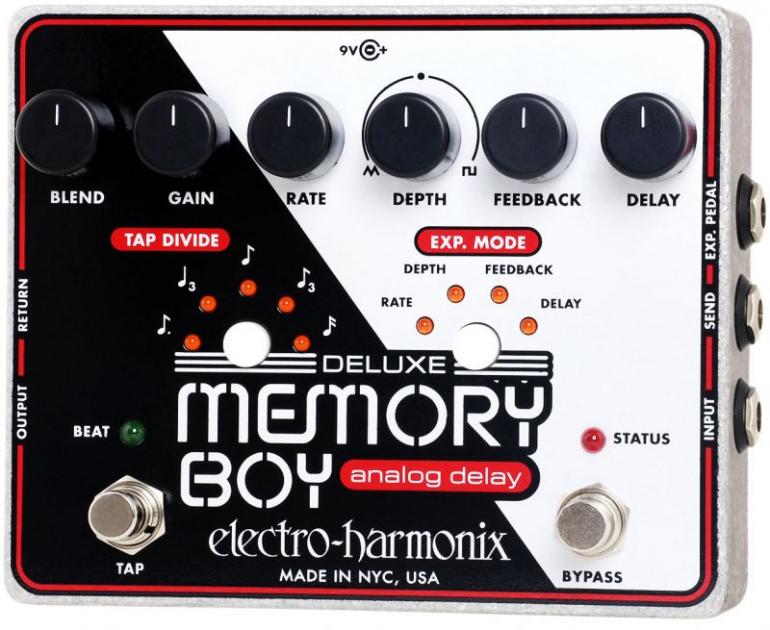
Delay: This effect sounds great to addatmosphere to a track. The gentle bell sound of the Rhodes sounds amazing with the repeat of delay, especially with a little modulation. Ilove Electro Harmonix effects for this. They are easy to use and haveinteresting modulation features that add unusual shimmers to the sound. Here'sthe Memory Boy in action. Skip to 1:08:

So, that should give you some ideas abouteffects for Rhodes. Experiment with differenteffects too. Try to find your own personal style!
Let's dive in to some players! Last monthwe were speaking about Martin Kratochvil who's work with Jazz Q is a great example of what this instrument can do . This month I would like to take a lookat the style of two more great players, Michal Kocab and Vladimir Bar
Michael Kocáb is a Czech composer andpolitical activist who lead the group, Pražský výběr during the verypolitically turbulent 1980s. Michael's tasty riffs are the perfect backdrop forthis soulful track with Michal Pavlicek and Vera Bila:
https://www.youtube.com/watch?v=8gidSoWza-M
We can't enclose exact transcriptionsbecause of copy write laws, so I've come up with a few examples to give you theflavor of each technique.

In ex 1 we have a few diatonic chordsmoving over a bass note much like Kocab does. I've put a few more chords in andmoved the key to D. The first two beats has an arpeggio with the root and 5ththat is handed over to the right hand D major triad on beat 2+. The voicingslips up to an Em triad then back down again with the left hand supplying acontrary motion up to the 3rd, (F#) in the left hand. Bar 2 sustains before aleft hand fill into back to back cadences with a bass line that walks down theD major scale from 4 to 1. In the right hand we have a very simple cadence from a G triad to a D triad. Allof the material for this excercise is in fact from the D major scale. On yourown, practice playing diatonic chords up and down the major scales in 12 keysto be able to play like this in any key
Here's a two fisted Rhodes riff with a phaser effect like we spoke about above. This one is influenced bythe 1979 Prazsky Vyber song, Jsem Z Toho Jelen:
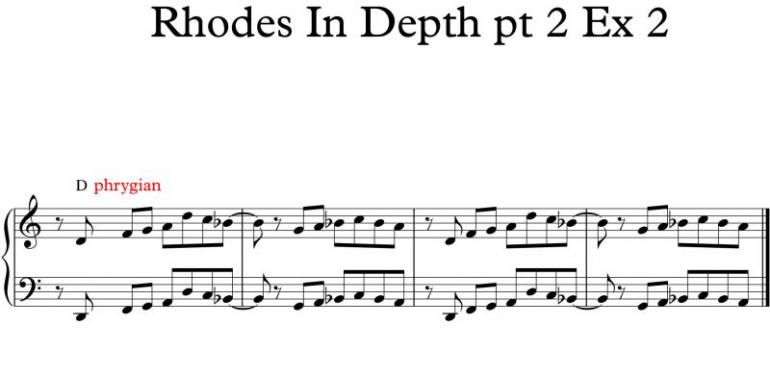
Our example utilizes the D Natural MinorScale (D, E, F, G, A, Bb, C, D) and has the right hand doubled two octavesbelow in unison. We start out with a pentatonic phrase that goes up an octavethen descends highlighting the Bb note. If you really want to spice things up,put some ring modulation on the sound to make it very dissonant.
In searching for albums and players for thearticle, I stumbled on a great Jan Spálený album called Edison from 1978. Spaleny is a composer who graduated from the Prague Consevatory onTuba and started the well known group, ASPM. Edison sets poems of Vitezslav Nezval to music with a very interesting progressiverock approach. The keyboardist on the album is Vladimir Bar who plays great Rhodes throughout. Lets listen to how Bar harmonizes chords over a pedal on track 1:
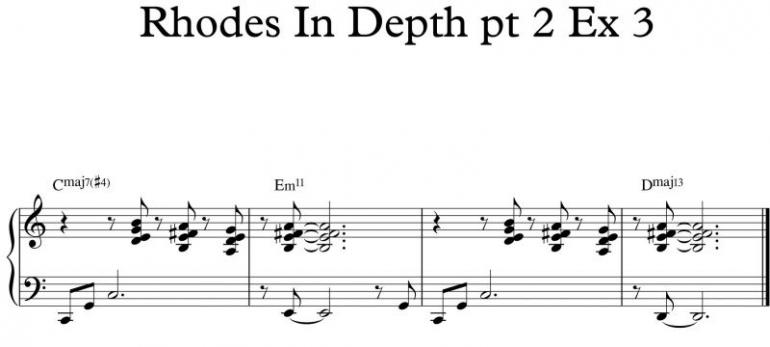
Our example #3 is in the key of C. The lefthand provides a grounded bass line as the right hand drops 4 note chords withdissonant 2nds. All the notes here are from the C Lydian Scale (C, D, E, F#, G,A, B, C). Notice in bar 2 and 4 how the bass line moves to a different rootnote creating nice harmonic movement with the Em11 shape of bar 2 and D13 shapeof bar 4.
The second song on Edison is in 7/4 and has a cool ostinato in the bass and sparkley offbeat chords ontop:
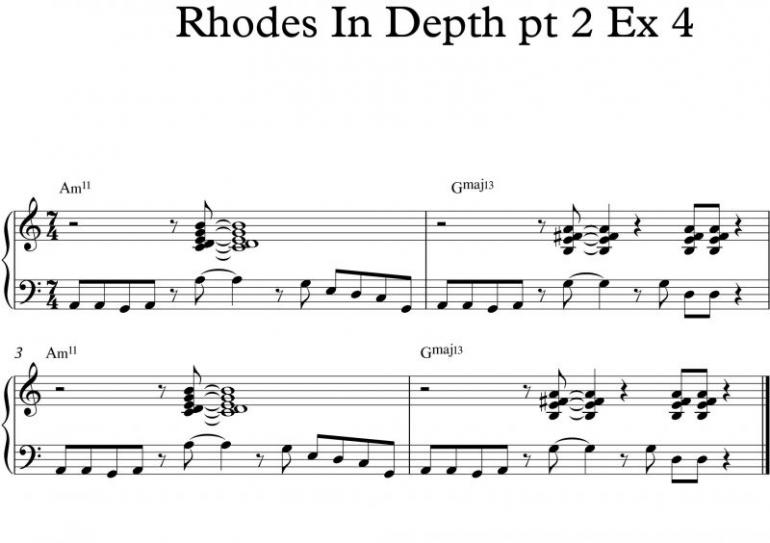
Our example #4 is in the A Dorian mode (A,B, C, D, E, F#, G, A). This one also sounds great with the phaser effect. Thebass line in the left hand is a simple pentatonic blues line. The dense Am11stab sounds great on top. You can play the C, D, and E all with your thumb soit sounds like you have 5 fingers! Let the voicing ring out so the phaser cancreate a swirl of sound. The right hand chords in Bar 2 stay on the off beatsand create a GMaj9 harmony when the bass hits on beat 3 +. The bar ends with afew 1/8 note stabs of the same chord over a D bass note this time.
Fráze a hudební termíny:
Phaseshifter:
Označení efektu, který častěji nazýváme phaser. Pokud nevíte, jak phaser zní, najděte si ukázku na YouTube a získáte lepší představu, než vám na těchto řádcích dokážeme poskytnout my. Podrobný popis, jak phaser funguje, pak najdete na www.muzikus.cz/pro-muzikanty-clanky/Jak-pracuji-efekty-I~19~leden~2009.
Shimmer:
Pokud si najdete tento výraz ve slovníku, dostane se vám překladu„třpyt“ apod. Co to však znamená v hudebním kontextu? Za „třpytivý“(shimmery) se v angličtině většinou označuje zvuk, ve kterém „dochází k pohybu ve vysokých frekvencích“. V našem článku je tímto pohybem svištění phaseru, ale často se tako označuje efekt octave reverb, který je dobře slyšet např. ve skladbě With or Without You od U2.
Diatonicchords:
Obecně se přídavné jméno diatonická používá pro sedmitónové stupnice, kde jsou každé dva sousední stupně vzájemně vzdálené buď celý tón nebo půltón. Diatonické akordy jsou pak odvozeny od jednotlivých tónů dané stupnice. Např. pro stupnici C dur by to byly akordy C, Dm, Em, F, G,Ami a Hm7/5b.
Cadence:
Slovo kadence má v hudbě několik významů. V harmonii av našem článku je výraz použit jako harmonické rozuzlení či návrat doharmonické rovnováhy, většinou v podobě sledu dvou akordů na konci hudební fráze.
Twofisted:
Synonymní fráze pro two handed, tedy obouruční či dvouruční.
Dissonant:
Disonantní, disharmonický či harmonicky nestabilní.Používá se obecně pro méně libozvučné souzvuky (obsahující např. malou sekundu,zmenšenou kvintu apod.) Pocit libozvučnosti však závisí velkou měrou na vkusu a hudebním vzdělání posluchače.
4note chords:
Za čtyřtónové označujeme většinou takové akordy, které kromě základního kvintakordu (tónika, tercie, kvinta)obsahují ještě čtvrtý tón (např. septimu).
Ostinato:
Tonální prodleva, tedy jednoduchá hudební fráze, která se „motá“kolem stejného tónu.
Off-beat:
Takto označujeme každou sudou neboli lehkou dobu. Poněkud matoucí ale je, že se tím někdy myslí sudé čtvrťové noty, a jindy sudé osminy. Celkověse dá říct, že pokud skladba obsahuje mnoho tónů hraných na sudé osminové doby, považujeme za off-beaty právě je. Je tedy třeba znát konkrétní hudební kontext.
Stab:
Ve slovníku najdete překlad bodnutí (nožem, nikoliv hmyzem), ale v hudebním žargonu toto slovo znamená krátký a výrazný vícehlasý akcent,zpravidla hraný ve vyšších oktávách. Nejčastěji se s pojmem setkáme u dechových sekcí, ale někdy se používá i u kláves.
Swirl:
Výraz v hudbě používaný pro „bublavý“ zvuk, jaký produkuje např. rotace reproduktoru Leslie nebo modulační efekty jako phaser či flanger.


